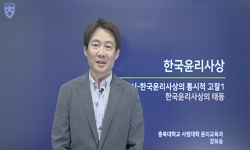The aim of this study is to investigate an educational meaning on Wonhyo's Muaemu(dance free from every attachment). This study puts focus on the dance's form, buddhist thoughts symbolized in the movements, and their educational meaning. The dance was...
http://chineseinput.net/에서 pinyin(병음)방식으로 중국어를 변환할 수 있습니다.
변환된 중국어를 복사하여 사용하시면 됩니다.
- 中文 을 입력하시려면 zhongwen을 입력하시고 space를누르시면됩니다.
- 北京 을 입력하시려면 beijing을 입력하시고 space를 누르시면 됩니다.
https://www.riss.kr/link?id=A60017284
- 저자
- 발행기관
- 학술지명
- 권호사항
-
발행연도
2011
-
작성언어
-
- 주제어
-
KDC
370
-
등재정보
KCI등재
-
자료형태
학술저널
- 발행기관 URL
-
수록면
65-94(30쪽)
- DOI식별코드
- 제공처
- 소장기관
-
0
상세조회 -
0
다운로드
부가정보
다국어 초록 (Multilingual Abstract)
The aim of this study is to investigate an educational meaning on Wonhyo's Muaemu(dance free from every attachment). This study puts focus on the dance's form, buddhist thoughts symbolized in the movements, and their educational meaning. The dance was originated by the famous buddhist monk, Wonhyo who lived in the periods of Three Kingdoms and Unified Silla. Wonhyo taught buddhist thoughts that were too difficult to understand for the illiterate by the method of the dance and song that everyone could do and enjoy. As a result, the Buddhism of Silla was known to everyone including beggars, the poor, and even innocent kids. It proved that the education through the dance was very effective. So the dance was played every place where people could meet. However in the periods of Koryo and Choseon Dynasty, the dance was performed in the court in the form of established pattern by the female entertainers. The movements of this dance were as follows: With the round gourd in hand he moves back and forth. He sways his two arms high in the air and lifts his legs three times with his belly vacant and his neck drooped. These movements symbolize collectively Wonhyo's buddhist thoughts that we should live free from every care and attachment, transcend the worlds of desires, and accept and respect everyone as respectable Buddha in the sea of one cosmic mind. To spread Wonhyo's dance of Muae, Korean traditional dances including Muaemu should be placed in the regular curriculum of preschool, primary school, and secondly school.
목차 (Table of Contents)
- Ⅰ. 서언
- Ⅱ. 무애무의 의미
- Ⅲ. 무애무의 형태
- Ⅳ. 무애무에 내포된 불교사상
- Ⅴ. 무애무의 교육적 의미
- Ⅰ. 서언
- Ⅱ. 무애무의 의미
- Ⅲ. 무애무의 형태
- Ⅳ. 무애무에 내포된 불교사상
- Ⅴ. 무애무의 교육적 의미
- Ⅵ. 결언
- 참고문헌
동일학술지(권/호) 다른 논문
-
- 한국교육철학회
- 김정래(Kim Jeong-Nae)
- 2011
- KCI등재
-
- 한국교육철학회
- 김태오(Kim Tae-O)
- 2011
- KCI등재
-
- 한국교육철학회
- 안신국(Ahn, Shin-Guk)
- 2011
- KCI등재
-
- 한국교육철학회
- 오창진(Oh, Chang-Jin)
- 2011
- KCI등재





 스콜라
스콜라





